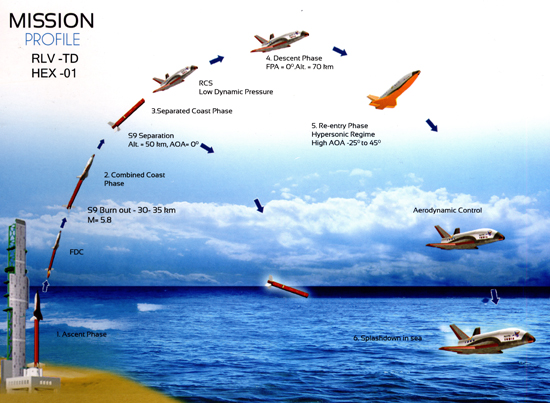Reusable Launch Vehicle
 The cost of access to space is the major deterrent in space exploration and space utilisation. A
reusable launch vehicle is the unanimous solution to achieve low cost, reliable and on-demand
space access.
The cost of access to space is the major deterrent in space exploration and space utilisation. A
reusable launch vehicle is the unanimous solution to achieve low cost, reliable and on-demand
space access.
Reusable Launch Vehicle-Technology Demonstration (RLV-TD) Programme is planned as a series of technology demonstration missions that have been considered as a first step towards realising a Two Stage To Orbit (TSTO) fully reusable vehicle. A Winged RLV-TD has been configured to act as a flying test bed to evaluate various technologies using air breathing propulsion. These technologies will be developed in phases through a series of experimental flights.
RLV-TD HEX-01 Mission :
ISRO accomplished its maiden RLV-TD HEX-01 mission on May 23, 2016 from SDSC SHAR and successfully demonstrated the critical technologies for design and flight testing of re-entry vehicles. However,it was a suborbital flight and designed to land on sea.
RLV Landing Experiment (RLV-LEX) :
The major challenges of RLV technology has been successfully accomplished by ISRO in our previous missions. However, one of the critical technologies to be demonstrated is approach and autonomous landing on a runway. In order to acquire end-to-end RLV technology capability, this milestone has to be achieved before the RLV ORE mission.
For this, a Landing Experiment is planned (LEX)
In LEX, the RLV will be carried using a helicopter to an altitude of 3-5 km and released at a distance of approximately 4-5 km ahead of the runway with a horizontal velocity. After the release, the RLV glides, navigates towards the runway and carries out a conventional autonomous landing with a landing with a landing gear. This is planned in a Defence air field near Chitradurga in Karnataka.
RLV Orbital re-entry Experiment (ORE)
Now ISRO is working on ORE. In ORE, a wing body called Orbital Re-entry vehicle (ORV) will be taken to an orbit by an ascent vehicle derived from the existing GSLV and PSLV stages and stay in orbit for a stipulated period, re-enter and land in a runway autonomously with a landing gear.